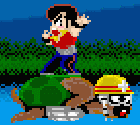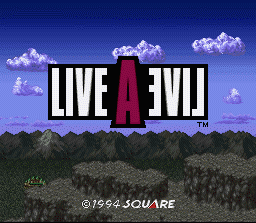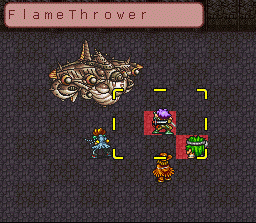 |
 |
 |
 |
|
| Main | Updates | Links | Contact |

         |
There was a time, long before FMVs and the standard Final Fantasy battle system, when the gaming industry felt that America was simply uninterested in RPGs. During this time, Squaresoft ported precious few (albeit badly translated) games from the Super Famicom to the SNES. Once they realized that they could sell RPGs, however, it was too late: countless games lost the chance of ever being released in the US. One of those games was Live A Live.
There are two things in Live A Live that keep it from being a carbon copy of every other RPG ever released: the strange, nearly impossible to describe turn-based / real-time / strategic battle system, and the division of the game into 9 differently themed chapters. In battles, all of the characters and enemies are arranged on a grid, and they can all move freely as much as they want. The only time the action stops is when either someone performs an attack, or you bring up a menu to choose an action for a character. There is no MP system; the only disadvantages to attacks are their start-up times, their ranges, and / or their areas of effect. In addition, HP refills and all fallen characters are revived at the end of every battle, you can save anywhere on any map, and there's a run success rate of 100% for all non-boss enemies. However, in most of the battles you face, the enemies are either as strong or stronger than you, and many have a good chance of beating you if you don't use any kind of strategy. Overall, the battle system does a great job of eliminating those annoying endurance-based dungeon-crawling excursions that we've come to expect from RPGs, instead replacing them with a format that makes you actually care about each battle you fight. The chapters range from the battle-only Wrestling scenario to the almost completely battle-free Sci-Fi scenario, with a whole bunch of other interesting concepts in between which, for one reason or another, Squaresoft just couldn't make an entire game out of. They are, in semi-chronological order:
Prehistoric Chapter: Probably the most interesting of all the chapters. The chapter supposedly takes place before language is developed, so all of the "dialogue" is replaced by word bubbles containing pictures. As a result, the plot is incredibly simple, and the characters aren't well developed. Not that that really matters though: this is the one chapter in the game that really focuses on humor. The "smell" system is interesting as well: on the map screen, enemies are invisible, but you can pinpoint their locations and avoid battles by sniffing the air with the Y button (causing puffs of scent to appear where they were when you sniffed the air).
Kung-Fu Chapter: Wise old master of the ancient art of Shinkansen (which, incidentally, means "Bullet Train") must find a pupil, or the fighting style will disappear forever. Not much to say about this one, except for the fact that you indirectly get to choose who ends up being the main character in the end. It gets a little dull towards the end when both of the characters you control have almost exactly the same special moves, though (well, unless you leveled up a lot). I do like that crazy karate yelp sound effect, though.
Ninja Chapter: Now this is a chapter. Sneak around a palace in feudal Japan on a mission to rescue a prisoner, hide from guards using ninja camouflage, and banish ancient Japanese demons and huge 50-foot long goldfish to the land of wind and ghosts. Not only that, but you get special items for either using your mad ninja skillz to avoid killing anyone in the castle, or using those same skillz to slaughter all 100 of it's residents, geishas and (relatively) harmless old ladies included. Also, the "trap" battles you fight are set up very well: for example, in one, you have to run through a zig-zagging gauntlet of stationary enemies and kill their controller before they can self-destruct next to you.
Cowboy chapter: Not as good as the Ninja chapter, but very unique nonetheless. You only fight about 4 battles total; 3 which are more or less guaranteed wins, and a boss battle. The rest of the chapter consists of finding and setting up traps to take out a group of bandits as they ride into town -- the last battle consists of you against a big guy with a gatling gun, and anywhere from zero to fourteen other enemies, depending on how many you've killed with the traps. The only real problem I have with the chapter is that you'll almost get killed by the last boss's gatling gun unless you know about it beforehand (it does 999 damage no matter what, but it only shoots diagonally).
Wrestling chapter: No real plot, no real dialogue, nothing but battles. No maps or leveling up either; you choose who you fight from a stage select screen, and you gain new moves by getting hit by them. Needless to say, most of the enemies will lay you out in no time unless you figure out a strategy to beat them.
Near-Future Chapter: Standard Mecha style; the entire plot is just a ripoff of Akira and Evangelion (in fact, the main character is even named Akira). Lots of motorcycle gangs, secret government organizations, orphans, teenage mecha pilots with psychological problems taking on the entire army of Japan, and even a big pool of LCL towards the end. And, if that weren't bad enough, it's virtually impossible to lose against the last boss. If it weren't for the fact that it used the Live A Live battle system, this chapter would be unbearable...
Sci-Fi Chapter: This chapter's gimmick is that there are no cumpulsory battles until the very end. As a tradeoff, it's completely plot-oriented, and it does a surprisingly good job of keeping you interested. Not bad, especially considering the balatantly ripped off plotline: both an alien that the government wants recovered at any cost and the AI controlling the ship's computers are trying to kill off the crew. Also, in case you find following the plot tedious after a time, the designers put in the incredible Captain Square mini-game. While the Captain Square game itself is just a series of nine battles using the Live A Live battle engine, these battles are what the engine was made for. The amount of strategy necessary to win makes it seem more like a puzzle game than an RPG. We're not just talking "kill the healer first" or "divide and conquer" strategy here; this is more like the best damned specimen of Square's RPG battle systems since the original Final Fantasy (make sure to find the hidden Memory Card if you plan on beating it, though. It gets incredibly annoying having to restart every time you die).
Medieval Chapter (Unlocked after the first 7 chapters are completed): The progression of the Medieval chapter is a lot like the progression of Neon Genesis Evangelion. The first part is incredibly cliched, and not particularly good: the plot is stale and predictable, and the battles are random and don't require much thought to win. Fortunately, also like Evangelion, all that changes about three quarters of the way through. For one thing, the plot makes a number of huge twists which totally change the context of the chapter. After a couple of these twists, the bosses all of a sudden become much harder and more interesting (the last few bosses are nigh impossible unless you can keep in their attacks' "blind spots"). And, finally, in a depressing, Evangelion-like conclusion, the hero ends up getting screwed over in every way possible. Lots of fun to be had by all.
Final Chapter (Unlocks after the Medieval chapter is completed, takes place in the same area): The I-could-beat-the-last-boss-right-away-if-I-wanted-to-but-I'm-going-to-get-all-the-characters-and-rare-items-first segment of the game. With the exceptions of a few new dungeons, the maps of the Final chapter are exactly the same as those of the Medieval chapter. At the beginning of the chapter, you choose one of the eight main characters to play as -- all of them, with the exception of Orsted (the main character of the Medieval chapter), have the same possible endings. Each character has his own starting point; although you only start with one, you can get a better ending by meeting them all (although you can only have up to 4 in your party at any one time, and you can't switch out the character you started with). This chapter is, not surprisingly, vastly different from all the others. While the gameplay isn't exactly repetitive (on the contrary; some of the dungeons are quite large, and the random enemy encounters change as your main character's level increases), the focus of the chapter isn't a variety of challenges. Rather, it puts more emphasis on the differences between the characters' abilities. For example, Akira can heal, and his attacks have a huge area of effect, but he's not good at dealing lots of damage to a single enemy. On the other hand, Sunset (the main character of the Cowboy chapter) has a number of good ranged attacks that hit a single target, but when he hits multiple enemies with an area attack, he seems to miss more often. The chapter does have its flaws, though. First off, many of the rare item locations are nearly impossible to find without a walkthrough to tell you where they are. And, the frequency of random battles gets annoying when you're looking for items; if you're anything like me, you'll end up running away literally hundreds of times (luckily, Square tried to account for this: there are a couple of hidden items that can only be found by running away a lot). If anything, the last boss is well designed. Live A Live is definitely one of the best RPGs for the Super Famicom. It's unique battle system sets it apart from every other RPG on the market. It has its problems, but they're not nearly bad enough to seriously detract from gameplay. And, perhaps most importantly, its sheer variety makes you want to keep playing all the way through. It isn't the greatest game Square has ever made, but it's close enough.
Rating: 4.8 out of 5 |
You are visitor #